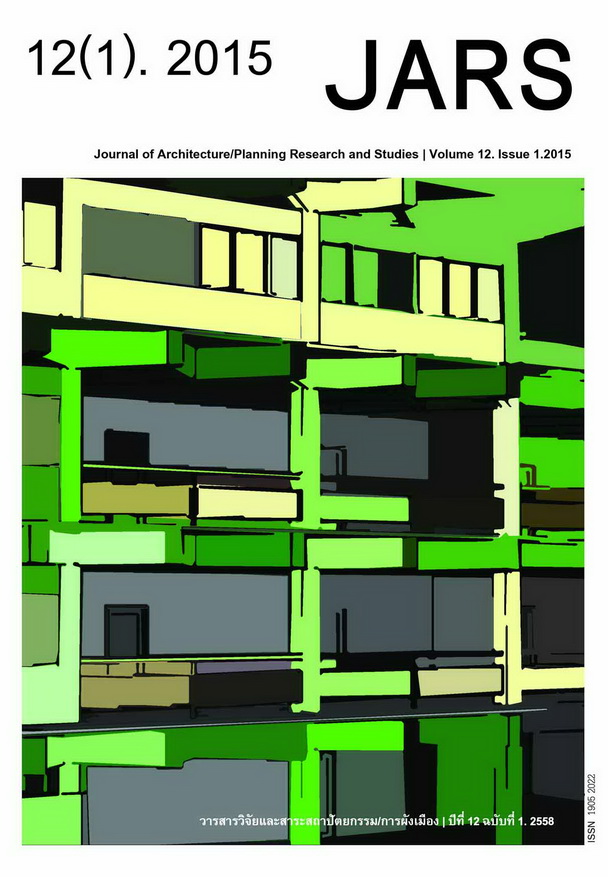Bridging the Horizon: A Collaborative and Cooperative Approach for Cross-cultural Learning on the Artistic and Architectural Heritages of Central and Northern Thailand.
Main Article Content
Abstract
Following a successful 2013 cross-cultural educational experience, faculty members and students fromKing Mongkut's Institute of Technology, Ladkrabang (KMITL) and University of Colorado Denver (UCD) againorganized a series of workshops and field trips to investigate artistic and architectural heritages in central andnorthern Thailand in January 2015. The program concluded with a joint exhibition of student research projectsat KMITL. The research methodology for the 2015 KMITL-UCD workshops and excursions analyzes the programfor its roles in: 1) expanding student knowledge of the artistic and architecture heritages in central and northernThailand; and 2) bridging a horizon of understanding between two groups of students; one grounded in theirown cultural roots in Thailand and the other not. Informed by Spencer Kagan's notion of Cooperative andCollaborative (C&C) learning, this paper explores the value and significance of cross-cultural study andexchange and demonstrates the value of collaborative and cooperative learning in architectural education.
Downloads
Article Details

This work is licensed under a Creative Commons Attribution-NonCommercial-NoDerivatives 4.0 International License.
All material is licensed under the terms of the Creative Commons Attribution 4.0 International (CC-BY-NC-ND 4.0) License, unless otherwise stated. As such, authors are free to share, copy, and redistribute the material in any medium or format. The authors must give appropriate credit, provide a link to the license, and indicate if changes were made. The authors may do so in any reasonable manner, but not in any way that suggests the licensor endorses you or your use. The authors may not use the material for commercial purposes. If the authors remix, transform, or build upon the material, they may not distribute the modified material, unless permission is obtained from JARS. Final, accepted versions of the paper may be posted on third party repositories, provided appropriate acknowledgement to the original source is clearly noted.
References
Aasen, C. (1998). Architecture of Siam: A cultural history interpretation. Kuala Lumpur: Oxford University Press.
Ben-Zaken, A. (2010). From ‘Incommensurability of Cultures’ to mutually embraced zones. In Ben-Zaken, A. (Ed.), Cross-cultural scientific exchanges in the eastern Mediterranean 1560-1660. Baltimore: Johns Hopkins University Press.
Bloom, H. (1975). A map of misreading. New York: Oxford University Press.
Bozdogan, S. (1999). Architectural history in professional education: Reflections on postcolonial challenges to the modern survey. Journal of Architectural Education, 52(4), 207-215.
Burke, P. (1997). Varieties of cultural history. Ithaca, N.Y.: Cornell University Press.
Carrier, J. (1995). Occidentalism: Images of the west. Oxford: Calrendon Press.
Ciaramicoli, A. P. & Ketcham, K. (2000). The power of empathy. New York: Plume.
Collins, N. (2013). English landscape painting (1700-1900): Origins, history, types. Encyclopedia of art history. Retrieved February 23, 2015, from http://www.visual-arts-cork.com/history-of-art/english-landscape-painting.htm.
Cooper, J. & Robinson, P. (1998). Small group instruction in science, mathematics, engineering, and technology. Journal of College Science Teaching 27, 383-387.
Gardner, H. (1993). Multiple intelligences. New York: Basic Books.
Gibson, J. (1966). The senses considered as perceptual system. Boston: Houghton-Mifflin.
Goleman, D. (1995). Emotional intelligence: Why it can matter more than IQ. New York: Bantam.
Goodman, H. (2002). Emotional literacy. The Teacher Trainer, 16(1), 1-23.
Hiss, T. (1990). The experience of place. New York: Vintage Books.
Kagan, S. (1994a). Cooperative learning. San Clemente, CA: Resources for Teachers.
Kagan, S. & Kagan, M. (1998b). Multiple intelligences: The complete MI book. San Clemente, CA: Resources for Teachers.
Kagan, S. (2009c). Kagan cooperative learning. San Clemente, CA: Kagan Publishing.
Karmel, R. (2012). The haptic sense. Writing by Robbie Karmel. Retrieved February 19, 2015, from http://rkarmel.com/2012/08/02/the-haptic-sense.
Kent, S. (1993). Domestic architecture and the use of space: An interdisciplinary cross-cultural study. Cambridge: Cambridge University Press.
Lefebvre, H. (1991). The production of space. Oxford: Basil Blackwell.
MacGregor, J. (1990). Collaborative learning: Shared inquiry as a process of reform. In Svinicki, M.D. (Ed.), The changing face of college teaching, New directions for teaching and learning. 42. San Francisco: Jossey-Bass.
Maltzahn, K. V. (1994). Nature as landscape: Dwelling and understanding. Montreal: McGill-Queen’s University Press.
Martin, C. B. & Deutscher, M. (1966). Remembering. Philosophical Review, 75, 161–196.
Metheny, E. (1975). Moving and knowing. Los Angeles: Peek.
Meyers, D. T. (1994). Subjection and subjectivity. New York: Routledge.
Mugerauer, R. (1995). Interpreting environments: Tradition, deconstruction, hermeneutics. Austin: University of Texas Press.
Noobanjong, K. (2013). The aesthetics of power: Architecture, modernity, and identity from Siam to Thailand. Bangkok and Singapore: White Lotus Press, 2013.
Noobanjong, K. & Ubonsri, B. (2013). An integration of project-based learning and haptic senses: A case study in architectural education. Journal of Architectural/Planning Research and Studies, 10(1), 165-188.
Parry, B. (1987). Problems in current theories of colonial discourse. Oxford Literary Review, 9(1&2), 27-58.
Perera, N. (1998). Society and space: Colonialism, nationalism, and postcolonial identity in Sri Lanka. Boulder: Westview Press.
Pieris, A. (2014). Beyond southeast asia: Repositioning national and regional identities through architectural discourse. Paper presented at the 1st Southeast Asia Architecture Research Collaborative Symposium, National University of Singapore, January 8-10, Singapore.
Poomsawai, C. (2010). Karin Klinkajorn on life is beautiful in samphrang. Retrieved February 22, 2015, from http://bk.asia-city.com/events/article/state-art-life-beautiful-samphrang#sthash.7bkSVlNd.dpuf.
Jarzombek, M. (1999). A prolegomenon to critical historiography. Journal of Architectural Education, 52(4), 197-206.
Rockwood, H. S. III. (1995a). Cooperative and collaborative learning. The National Teaching and Learning Forum, 4(6), 8-9.
Rockwood, H. S. III. (1995b). Cooperative and collaborative learning. The National Teaching and Learning, Forum 5(1), 8-10.
Said, E. (1978.) Orientalism. New York: Pantheon Books.
Sathapitanonda, N. & Mertens, B. (2012). Architecture of Thailand: A guide to tradition and contemporary forms. Singapore: Didier Millet,Csi.
Smith, B .L. & MacGregor, J. T. (1992). What is collaborative learning?. In Goodsell, A. S., Maher, M. R., & Tinto, V., (Eds.), Collaborative learning: A sourcebook for higher education. Syracuse: National Center on Postsecondary Teaching, Learning, and Assessment, Syracuse University.
Wyatt, D. (2003). Thailand: A short history (2nd Ed.). New Haven: Yale University Press.


